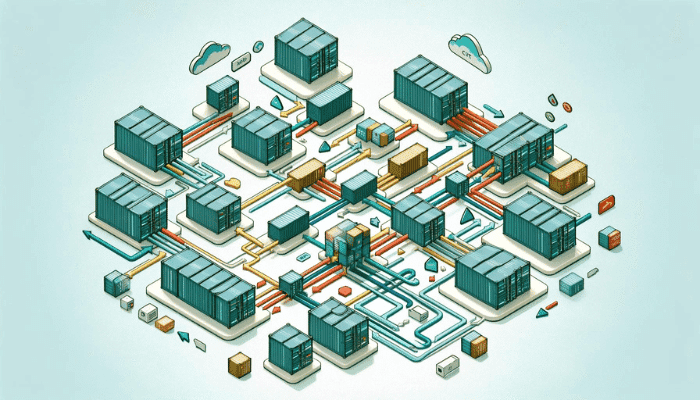Continuous Streaming of Kubernetes Logs with kubectl

Introduction
In the world of Kubernetes, continuous log streaming is crucial for effective debugging and monitoring. As applications run in distributed environments, having real-time access to log data helps you quickly identify and resolve issues, ensuring your systems remain healthy and performant.
The kubectl logs command is a powerful tool that allows you to access container logs within a pod, offering an invaluable glimpse into your application's behavior.
The importance of continuous log streaming cannot be overstated. It provides a live feed of log data, enabling developers and operators to monitor the state of their applications as they evolve. This capability is essential for diagnosing problems, verifying deployments, and maintaining an overall understanding of your system's health.
In this blog, we will explore how to effectively use the kubectl logs command for continuous log streaming. We will cover basic and advanced usage, practical tips for managing logs, and how to integrate these practices with observability tools like OpenObserve to enhance your monitoring and debugging efforts.
Next, we'll delve into the basics of using kubectl for log streaming, covering essential commands and parameters to get you started.
Understanding \`kubectl\` for Log Streaming
To harness the power of Kubernetes log streaming, you need to be well-versed with kubectl, the command-line tool for interacting with Kubernetes clusters. kubectl allows you to manage Kubernetes resources and provides access to logs, which is crucial for debugging and monitoring purposes.
Key kubectl logs Parameters
- -f (follow): This parameter enables live streaming of logs. By following the logs, you can see real-time output from your containers, which is essential for monitoring ongoing processes and diagnosing issues as they occur.
kubectl logs -f <pod-name> -c <container-name>
- --tail: This parameter allows you to display the last N lines of logs. It is useful when you need to quickly review the most recent log entries without scrolling through the entire log history.
kubectl logs --tail=<number-of-lines> <pod-name> -c <container-name>
- --since: This parameter lets you fetch logs from a specific timeframe, defined by a relative time such as "1h" for the last hour or "30m" for the last 30 minutes. It is particularly useful for investigating issues that occurred within a known period.
kubectl logs --since=<duration> <pod-name> -c <container-name>
- --timestamps: Including timestamps in your logs can provide better context for the events, making it easier to correlate log entries with specific incidents or time periods.
kubectl logs --timestamps <pod-name> -c <container-name>
By mastering these kubectl logs parameters, you can effectively tailor your log queries to meet your specific debugging and monitoring needs. In the next section, we will explore continuous log streaming methodologies, ensuring you can maintain a live feed of your application's log data.
Continuous Log Streaming Methodology
Continuous log streaming is a powerful technique for real-time monitoring and debugging of your Kubernetes applications. It allows you to keep an eye on logs as they are generated, providing immediate insights into the health and behavior of your containers.
Real-Time Log Streaming with kubectl
Using the -f (follow) parameter with kubectl logs is the most straightforward way to stream logs in real-time. This method ensures that you are constantly updated with the latest log entries from your container.
kubectl logs -f -c <container-name> <pod-name>
Tailoring Log Output
To manage the volume of logs being streamed, you can use the --tail parameter. This allows you to limit the log output to the last N lines, making it easier to handle and analyze.
kubectl logs --tail=<number-of-lines> -c <container-name> <pod-name>
Accessing Logs from Specific Timeframes
When you need to focus on logs from a particular period, the --since parameter is invaluable. It helps you retrieve logs starting from a specified duration in the past.
kubectl logs --since=<duration> -c <container-name> <pod-name>
Combining Parameters for Enhanced Log Streaming
You can combine multiple parameters to refine your log streaming further. For instance, you can follow logs in real-time while also limiting the output to recent entries with timestamps included for better context.
kubectl logs -f --tail=<number-of-lines> --since=<duration> --timestamps -c <container-name> <pod-name>
By effectively utilizing these parameters, you can streamline your log monitoring process, ensuring that you have access to the most relevant and recent log data. This is particularly useful for quickly identifying and resolving issues as they arise.
Practical Tips for Effective Log Streaming
Use Namespace Specifiers
Including the namespace specifier in your commands targets the specific pod or container within the desired namespace.
kubectl logs -f -n <namespace> <pod-name>
Ensure Pods are Running
Check that pods are in the Running state before attempting to stream logs to avoid errors.
kubectl get pods -n <namespace>
Using kubectl attach for Direct Streaming
For direct streaming of stdout and stderr, kubectl attach can be used. This method is helpful for interacting directly with a running container.
kubectl attach -it <pod-name> -c <container-name>
Restarting Log Streaming
If log streaming gets interrupted, restart it promptly to ensure continuous monitoring. The watch command can automatically refresh the kubectl logs output at regular intervals.
watch kubectl logs -f <pod-name>
Exploring Third-Party Tools
Tools like OpenObserve, offer enhanced log viewing and management capabilities. These tools provide more user-friendly interfaces and additional features for monitoring Kubernetes logs.
OpenObserve:
OpenObserve is a powerful observability platform that can be integrated with Kubernetes for advanced log management and visualization. It provides real-time data streaming, unified log aggregation, and sophisticated dashboard capabilities.
- Real-Time Data Streaming: OpenObserve allows you to monitor logs and metrics as they are generated, providing immediate visibility into your system's performance.
- Unified Log Aggregation: Collect logs from multiple sources into a single, cohesive view, making it easier to correlate events and diagnose issues.
- Advanced Visualization Tools: Create detailed dashboards to visualize log data, helping you identify patterns and trends quickly.
Ready to enhance your Kubernetes log management with OpenObserve? Sign up for a free trial on our website, explore our GitHub repository, or book a demo to see how OpenObserve can transform your observability strategy.
By mastering these techniques and leveraging tools like OpenObserve, you can ensure comprehensive monitoring and rapid issue resolution in your Kubernetes environment.
Next, we will look at how to manage log streaming in multi-pod and multi-container environments, which is essential for monitoring complex Kubernetes applications.
Multi-Pod and Multi-Container Log Streaming

In Kubernetes, applications often span multiple pods and containers, making it crucial to have efficient methods for streaming logs from various sources simultaneously. Here are some techniques to help you manage log streaming in complex environments.
Streaming Logs from Multiple Pods
When dealing with multiple pods, tools like kubetail can simplify the process. kubetail allows you to aggregate logs from multiple pods into a single stream, making it easier to monitor applications that scale across numerous instances.
kubetail <pod-prefix>
Tailing Logs from All Containers within a Pod
To stream logs from all containers within a specific pod, you can use the -c parameter. If your pod contains multiple containers, specifying the container name ensures you get the logs from the desired source. However, you can omit the container name to get logs from all containers.
kubectl logs -f <pod-name>
Accessing Logs from Specific Containers
If you need logs from a particular container within a pod, specifying the container name helps filter the log stream effectively.
kubectl logs -f -c <container-name> <pod-name>
Next, we'll discuss handling the limitations of kubectl logs and integrating with third-party log management systems for advanced features.
Handling Log Streaming Limitations
While kubectl logs is a powerful tool, it has its limitations, especially for comprehensive log management. Understanding these limitations and integrating additional tools can enhance your log monitoring capabilities.
Limitations of kubectl logs
- Ephemeral Nature: Logs are lost when pods are deleted or restarted, making it challenging to track issues over time.
- Limited Storage: The default log retention might not be sufficient for long-term analysis.
- Scalability: Managing logs manually in large-scale environments can be cumbersome.
Combining kubectl with Third-Party Log Management Systems
To overcome these limitations, you can integrate kubectl with third-party log management systems. These systems provide advanced features like long-term storage, better scalability, and enhanced querying capabilities.
OpenObserve Integration:
OpenObserve can seamlessly integrate with Kubernetes to enhance your log management setup. Here’s how OpenObserve can address the limitations of kubectl logs:
- Persistent Storage: OpenObserve stores logs persistently, ensuring you have access to historical data for long-term analysis.
- Scalability: With OpenObserve, you can handle logs from large-scale environments efficiently. Its architecture supports high data volumes without performance degradation.
- Advanced Querying and Visualization: OpenObserve offers powerful querying capabilities and customizable dashboards, making it easier to analyze log data and extract meaningful insights.
To integrate OpenObserve with your Kubernetes setup, follow these steps:
- Set Up OpenObserve: Deploy OpenObserve in your environment and configure it to receive logs from your Kubernetes cluster.
- Configure Fluent Bit: Use Fluent Bit as a log forwarder to send logs from Kubernetes to OpenObserve. Ensure Fluent Bit is configured to collect logs from all necessary sources and forward them to OpenObserve.
- Create Dashboards: In OpenObserve, create dashboards to visualize your log data. Customize the dashboards to highlight key metrics and trends relevant to your monitoring needs.
For detailed configuration steps, refer to the OpenObserve documentation or explore our GitHub repository.
By integrating OpenObserve with your Kubernetes setup, you can achieve a more comprehensive and scalable log management solution, overcoming the inherent limitations of kubectl logs.
Next, we'll explore how to leverage observability platforms for in-depth log analysis, providing you with actionable insights to enhance your monitoring strategy.
Log Analysis with Observability Platforms
Effective log analysis is crucial for maintaining the health and performance of your Kubernetes cluster. Observability platforms can enhance your log monitoring capabilities by providing advanced features and deeper insights into your log data.
Integrating Kubernetes Log Monitoring with OpenObserve
OpenObserve is an observability platform that can significantly improve your log analysis process. By integrating OpenObserve with your Kubernetes setup, you gain access to advanced log management features that go beyond the capabilities of kubectl logs.
Benefits of OpenObserve Integration:
- Live Tail Logging: OpenObserve supports live tail logging, allowing you to monitor logs in real-time and quickly identify issues as they occur.
- Advanced Log Query Builders: Use powerful query builders to filter and search through log data, making it easier to pinpoint specific events or trends.
- Customizable Dashboards: Create and customize dashboards to visualize log data and key metrics, helping you gain actionable insights into your cluster's performance.
- Alerting and Notifications: Set up alerts for specific log patterns or thresholds to ensure timely responses to potential issues.
Conclusion
Continuous log streaming is vital for maintaining the health and performance of your Kubernetes clusters. By leveraging the power of kubectl logs, you can gain real-time insights into your container logs, enabling effective debugging and monitoring. This guide has provided an overview of using kubectl for log streaming, detailed practical tips for effective log streaming, and highlighted the limitations of using kubectl logs alone.
To enhance your log monitoring capabilities, integrating advanced observability platforms like OpenObserve is highly recommended. OpenObserve offers comprehensive log management features, real-time alerts, and advanced data visualization tools that go beyond the native capabilities of kubectl logs. By combining these tools, you can achieve a robust and efficient log monitoring setup for your Kubernetes environment.
Ready to take your Kubernetes log monitoring to the next level? Sign up for a free trial of OpenObserve on our website, explore our GitHub repository for setup details, or book a demo to see OpenObserve in action. Ensure your Kubernetes applications run smoothly and efficiently with advanced log analysis and monitoring solutions.
Author:

The OpenObserve Team comprises dedicated professionals committed to revolutionizing system observability through their innovative platform, OpenObserve. Dedicated to streamlining data observation and system monitoring, offering high performance and cost-effective solutions for diverse use cases.
